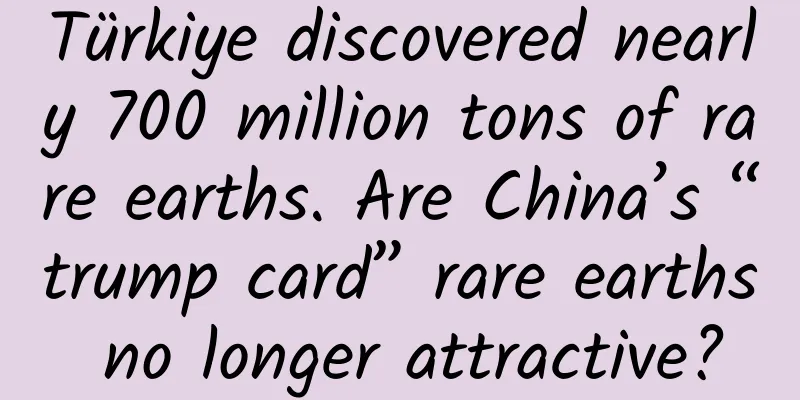Türkiye discovered nearly 700 million tons of rare earths. Are China’s “trump card” rare earths no longer attractive?

|
Türkiye's discovery of nearly 700 million tons of rare earth reserves has attracted great attention. Industry experts say this rare earth is not the same as that rare earth. Will it shake China's position as a major rare earth country? Compiled by New Media Editor Lv Bingxin In the past two days, the news that "Turkey has discovered nearly 700 million tons of rare earth elements" has sparked heated discussions. According to the latest data disclosed by the United States Geological Survey in 2022, the current global rare earth reserves are only 120 million tons. If the 700 million tons of rare earths found in Turkey refer to reserves, then it will obviously have a significant impact on the global market. However, is this information accurate? Will Türkiye's move shake China's position as a rare earth power? 694 million tons? This rare earth is not that rare earth On July 5, Turkey's discovery of a large amount of rare earth resources caused heated discussions. According to CCTV News, the Turkish Ministry of Energy and Natural Resources said that 694 million tons of rare earth elements were discovered in the Beylikova area of Eskişehir, Turkey. Turkey said that it is expected to start the construction of industrial facilities within the year. (Image source: CCTV News screenshot) However, according to data from the United States Geological Survey (USGS), the world's proven rare earth resource reserves are 120 million tons. Türkiye's new discovery can actually increase the world's rare earth reserves several times? In this regard, an authoritative expert in the industry who declined to be named said that the relevant data has yet to be verified, and the 694 million tons of rare earth elements may not be reserves of rare earth oxides, but rather ore reserves. The industry usually uses rare earth oxides (REO) as a statistical caliber for rare earth reserves, production and sales. According to data from the United States Geological Survey (USGS), the world's proven rare earth resource reserves of 120 million tons refer to the reserves of rare earth oxides. Among them, China's reserves are about 44 million tons, accounting for 37%, ranking first in the world. If the "694 million tons of rare earth elements" refers to 694 million tons of rare earth oxides, then this is equivalent to 5.8 times the world's proven rare earth reserves, and the impact on the existing rare earth market and rare earth prices cannot be underestimated. For this reason, the authenticity of Türkiye's newly discovered rare earth reserves has been questioned. According to the original text of the relevant content of the Turkish Ministry of Energy and Natural Resources, 694 million tons of rare earth elements were indeed mentioned, but it was not specified whether it was the reserves of rare earth oxides or ore reserves. When talking about future mining plans, Turkish Minister of Energy and Natural Resources Fatih said, "We will process 570,000 tons of ore each year and obtain 10,000 tons of rare earth oxides from the processed ore (Note: Youdao translation)." According to this conversion ratio, if the 694 million tons of rare earth elements discovered this time are ore reserves, they can be converted into about 12.18 million tons of rare earth oxides. Therefore, "ore reserves" is only a concept of potential mineral resources, and there is a big difference between the concepts of "rare earth oxides" that can be converted into production capacity. Depending on the production process of mineral resources, "reserves" are generally much less than "resources". An industry expert who wishes to remain anonymous said that when discussing Turkey's newly discovered reserves, the first thing to look at is whether it is the amount of minerals or rare earth oxides, the second is the ore grade, and the third is the ore selectivity. "I estimate that it is about 700 million tons of ore." The data of Turkey's newly discovered reserves is yet to be further verified. It should be pointed out that according to reports from the mining industry, the construction period of rare earth projects is relatively long. Generally, the construction period of a rare earth project takes 5 to 10 years, and it will take a long time and a large investment to be able to produce. In addition, Turkey currently does not have a complete rare earth smelting process. Therefore, based on comprehensive judgment, the impact of this newly discovered rare earth mine on the global rare earth market in the short term is very limited. How important are rare earth resources? Rare earth is actually a general term for 17 metal elements, including the lanthanide elements lanthanum (La), cerium (Ce), praseodymium (Pr), neodymium (Nd), promethium (Pm), samarium (Sm), europium (Eu), gadolinium (Gd), terbium (Tb), dysprosium (Dy), holmium (Ho), erbium (Er), thulium (Tm), ytterbium (Yb), lutetium (Lu), plus scandium (Sc) and yttrium (Y) in the same group. Rare earths play an irreplaceable role in national defense, new energy, new materials, energy conservation and environmental protection, aerospace, electronic information and other fields. They are called "industrial vitamins", "the mother of new materials" and "the core of the military" and are non-renewable resources. To be more specific, rare earths are actually used in our daily lives. From mobile phones and computer hard drives to electric car motors and MRI machines in hospitals, rare earths are needed. These minerals can also be found in key components such as catalysts, permanent magnets and metal alloys, affecting our daily lives. Unmanned vehicles, clean energy and communication systems are also considered to be the future economic growth areas that need rare earths. For example, a wind turbine with an installed capacity of 1 megawatt requires about 171 kilograms of rare earths. In the military field, they are widely used in precision-guided weapons, satellites and stealth technology. A US F-35 fighter requires about 427 kilograms of rare earths, and a Virginia-class nuclear submarine consumes up to 4.2 tons of rare earths. In view of this, Western developed countries such as Japan, the United States and the European Union attach great importance to the research on rare earths. In terms of global reserves, data released by the United States Geological Survey showed that the world's total reserves of rare earth resources in 2021 were approximately 120 million tons, with China's reserves being 44 million tons, Vietnam's reserves being 22 million tons, Brazil's reserves being 21 million tons, and Russia's reserves being 21 million tons. The four countries together account for 86% of the world's reserves. In terms of production, according to statistics from Asian Metal, the global rare earth production in 2021 was approximately 277,000 tons, and China's rare earth production was 168,000 tons, ranking first in the world, accounting for as high as 61%. In recent years, as rare earth products have received increasing attention from countries around the world, the global rare earth production pattern is changing. The world's newly discovered rare earth resources reserves are increasing, and a diversified supply pattern represented by the United States, Australia, Myanmar, etc. has been formed. The multi-point release of production capacity has had a certain impact on my country's rare earth market supply structure. my country occupies a leading position in the field of rare earth smelting and separation According to the white paper "China's Rare Earth Situation and Policy" released by the State Council Information Office, my country's rare earth resources are not only abundant in reserves, but also have the advantages of complete types of minerals and rare earth elements, and reasonable distribution of rare earth grades and mining sites, which have laid a solid foundation for the development of China's rare earth industry. Rare earths are not rare. For example, cerium, the rare earth element with the highest average content in the earth's crust, is more common than copper. Previously, there were few rare earth ores that could be mined, and they were difficult to separate, purify and process, so they were called rare earths. Therefore, the reason why China has become a major rare earth producer is not only because of its quantity, but more importantly, because it has accumulated considerable advantages in mining and refining. All of this started with the continuous research and unremitting efforts of scientists on technology since the 1970s. Before the 1970s, China's rare earth research and technology were almost completely backward. my country had to export rare earth concentrates at low prices and then purchase deep-processed rare earth products at dozens of times the price. The backward situation forced the Chinese to develop their own rare earth separation technology. In 1972, Professor Xu Guangxian of the Department of Chemistry at Peking University received an urgent task - to separate praseodymium and neodymium. Praseodymium and neodymium are the two most difficult elements to separate among rare earths, and were recognized as a world problem at the time. In such a critical situation, Xu Guangxian resolutely devoted himself to research related to rare earths. For Xu Guangxian, this was his third time to change his research direction, but only for one reason - the motherland needed him! It was also for this reason that Xu Guangxian, who was studying in the United States, was inspired by his motherland and resolutely returned to China. At that time, the Korean War had already broken out and Sino-US relations were extremely tense. Xu Guangxian and his wife Gao Xiaoxia both felt that the motherland needed them more. Gao Xiaoxia resolutely interrupted her degree studies and Xu Guangxian gave up the job that was about to be in hand. The couple returned to China by boat in 1951 under the pretext of overseas Chinese returning to visit relatives. Foreign countries usually use ion exchange to separate praseodymium and neodymium, but the output is small and the cost is high. Xu Guangxian decided to take a different approach and use the extraction method. Based on basic research and focusing on national goals, he did not follow foreigners and took his own innovative path. Three years later, this difficult problem that stumped rare earth researchers at home and abroad was really solved by Xu Guangxian's team, allowing the purity of China's rare earths to reach an astonishing 99.99%. Thanks to this technology, China has successfully achieved a counterattack from a country with a large number of rare earth resources to a country with a large number of rare earth production and export. After decades of development, China's rare earth industry has accumulated certain technical strengths and has made great progress in production level. Today, my country's share of the world market's rare earth raw material supply is gradually declining. In the mining and refining of rare earths, China has accumulated considerable advantages. A large amount of rare earth raw materials can be deeply processed domestically and exported with higher added value. Moreover, since many countries need to export rare earth semi-finished products to China for refining, China already has a decisive voice in these links. According to statistics, more than 80% of the world's rare earth industry is concentrated in China. The only light rare earth separation plant outside of China is located in Malaysia and belongs to Australia's Lynas Corporation. In addition, rare earth projects in other countries are only at the stage of raw ore mining, and there is no rare earth separation technology application. From the perspective of the entire industry, my country's rare earth industry is in the lead in mining, smelting and separation technology, and environmental protection management, and it can be said that it is at the "leading" level. In terms of high-tech materials such as permanent magnets, hydrogen storage, and luminescence, it is in the world's leading position. However, some people pointed out that China's rare earth production over the years has brought huge environmental costs. my country should continue to promote the upgrading of the rare earth industry, so that resources do not need to be outflowed cheaply and can create greater value, and more investment can be made in environmental protection, and many problems can be solved. (Content sources: Daily Economic News, Earth Knowledge Bureau, Mining Industry, Military Sub-Plane, etc.) Produced by: Science Central Kitchen Produced by: Beijing Science and Technology News | Beijing Science and Technology Media Welcome to share to your circle of friends Reproduction without authorization is prohibited |
<<: If a wild boar falls down, will a passing wild boar help it?
>>: This flower in Qinling Mountains has been playing hide-and-seek with humans for 100 years
Recommend
What is the correct way to take advantage of the college entrance examination hot spots?
The college entrance examination every year is an...
Why does "Hua Xizi" combine "online + offline" marketing?
" Hua Xizi " was born in Hangzhou, Chin...
To create a hit short video, keep these points in mind when writing a convincing copy!
The Internet industry changes its trends almost e...
Why do plants grow thorns? The answer lies in the Qinghai-Tibet Plateau
The "beauty" of the plant world is ofte...
It’s tiring to drill holes in lotus roots, and it’s even more tiring to drill holes in lotus stems!
The lotus is a symbol of purity, representing the...
15 little-known facts about WeChat, there is always one you don’t know
WeChat is one of the must-install software on eve...
Useful Tips | 230 essential jargon words for marketers!
We hate slang, but we can't completely get ri...
Lao Liang's Value Investment Stock Selection Course
Introduction to Lao Liang's Value Investment ...
After years of tangerine peels, they finally became tangerine peels
It's the season for oranges again, and friend...
Why are some tigers white? Few people know the truth behind this...
This article was reviewed by Zhao Xumao, a young ...
[NCTS Summit Review] Peking University Guo Yao: The Current Status and Challenges of the Mobile Application Ecosystem
On October 26, 2019, the second NCTS China Cloud ...
Xiaodu Tiantian Rotating Smart Screen T10: A smart home system hub that opens up new ways of bedroom entertainment
Nowadays, the concept of smart home and smart fam...
Starting from 322,800 yuan, the world's first 4C super fast charging plug-in hybrid MPV! Trumpchi New Energy E9 Super Fast Charging Edition is on the market!
On November 12, the Trumpchi New Energy E9 Super ...
How did Zhihu/Mafengwo/Boss Zhipin promote themselves during the World Cup?
Today, we will share from a practical operation p...
That Day丨It turns out that Yang Liwei flew into space 20 years ago!
20 years ago today A glorious page in the history...









